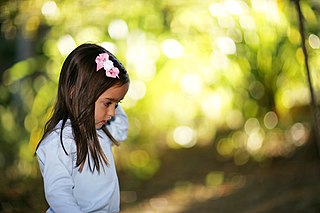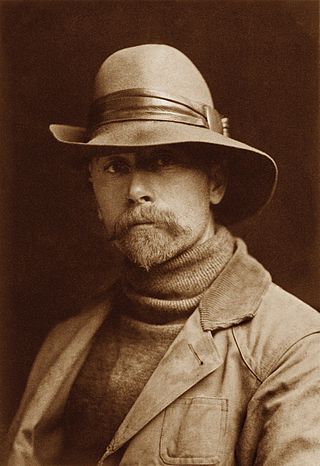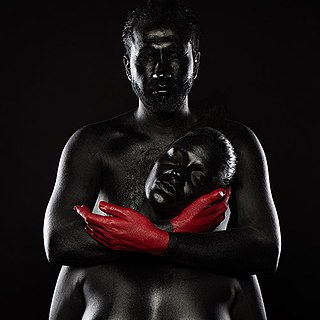
In photography, bokeh is the aesthetic quality of the blur produced in out-of-focus parts of an image. Bokeh has also been defined as "the way the lens renders out-of-focus points of light". Differences in lens aberrations and aperture shape cause very different bokeh effects. Some lens designs blur the image in a way that is pleasing to the eye, while others produce distracting or unpleasant blurring. Photographers may deliberately use a shallow focus technique to create images with prominent out-of-focus regions, accentuating their lens's bokeh.

A portrait is a painting, photograph, sculpture, or other artistic representation of a person, in which the face and its expressions are predominant. The intent is to display the likeness, personality, and even the mood of the person. For this reason, in photography a portrait is generally not a snapshot, but a composed image of a person in a still position. A portrait often shows a person looking directly at the painter or photographer, in order to most successfully engage the subject with the viewer.

Underwater photography is the process of taking photographs while under water. It is usually done while scuba diving, but can be done while diving on surface supply, snorkeling, swimming, from a submersible or remotely operated underwater vehicle, or from automated cameras lowered from the surface.

Three-point lighting is a standard method used in visual media such as theatre, video, film, still photography, computer-generated imagery and 3D computer graphics. By using three separate positions, the photographer can illuminate the shot's subject however desired, while also controlling the shading and shadows produced by direct lighting.

The term composition means "putting together". It can be thought of as the organization of the elements of art according to the principles of art. Composition can apply to any work of art, from music through writing and into photography, that is arranged using conscious thought.

A snapshot is a photograph that is "shot" spontaneously and quickly, most often without artistic or journalistic intent and usually made with a relatively cheap and compact camera.

Arnold Abner Newman was an American photographer, noted for his "environmental portraits" of artists and politicians. He was also known for his carefully composed abstract still life images.

The key light is the first and usually most important light that a photographer, cinematographer, lighting cameraman, or other scene composer will use in a lighting setup. The purpose of the key light is to highlight the form and dimension of the subject. The key light is not a rigid requirement; omitting the key light can result in a silhouette effect. Many key lights may be placed in a scene to illuminate a moving subject at opportune moments.

Portrait Painting is a genre in painting, where the intent is to represent a specific human subject. The term 'portrait painting' can also describe the actual painted portrait. Portraitists may create their work by commission, for public and private persons, or they may be inspired by admiration or affection for the subject. Portraits often serve as important state and family records, as well as remembrances.

Rembrandt lighting is a standard lighting technique that is used in studio portrait photography and cinematography; it is also used in contrast with butterfly lighting It can be achieved using one light and a reflector, or two lights, and is popular because it is capable of producing images which appear both natural and compelling with a minimum of equipment. Rembrandt lighting is characterized by an illuminated triangle under the eye of the subject on the less illuminated side of the face. It is named for the Dutch painter Rembrandt, who occasionally used this type of lighting.

Portrait photography, or portraiture, is a type of photography aimed toward capturing the personality of a person or group of people by using effective lighting, backdrops, and poses. A portrait photograph may be artistic or clinical. Frequently, portraits are commissioned for special occasions, such as weddings, school events, or commercial purposes. Portraits can serve many purposes, ranging from usage on a personal web site to display in the lobby of a business.

Post-mortem photography is the practice of photographing the recently deceased. Various cultures use and have used this practice, though the best-studied area of post-mortem photography is that of Europe and America. There can be considerable dispute as to whether individual early photographs actually show a dead person or not, often sharpened by commercial considerations. The form continued the tradition of earlier painted mourning portraits. Today post-mortem photography is most common in the contexts of police and pathology work.

Forensic photography may refer to the visual documentation of different aspects that can be found at a crime scene. It may include the documentation of the crime scene, or physical evidence that is either found at a crime scene or already processed in a laboratory. Forensic photography differs from other variations of photography because crime scene photographers usually have a very specific purpose for capturing each image. As a result, the quality of forensic documentation may determine the result of an investigation, in that with the absence of good documentation, investigators may find it impossible to conclude what did or did not happen.
Paul Mpagi Sepuya is an American photographer and artist. His photographs focus heavily on the relationship between artist and subject. He often explores the nude in relation to the intimacy of studio photography. The foundation of Sepuya's work is portraiture. He features friends and muses in his work that creates meaningful relationships through the medium of photography. Sepuya reveals the subjects in his art in fragments: torsos, arms, legs, or feet rather the entire body. Through provocative photography, Sepuya creates a feeling of longing and wanting more. This yearning desire allows viewers to connect deeply with the photography in a meaningful way.
Judith Rose Dater is an American photographer and feminist. She is perhaps best known for her 1974 photograph, Imogen and Twinka at Yosemite, featuring an elderly Imogen Cunningham, one of America's first woman photographers, encountering a nymph in the woods of Yosemite. The nymph is the model Twinka Thiebaud. The photo was published in Life magazine in its 1976 issue about the first 200 years of American women. Her photographs, such as her Self-Portraiture sequence, were also exhibited in the Getty Museum.

Photographic lighting refers to how a light source, artificial or natural, illuminates the scene or subject that is photographed. Photographers can manipulate the positioning and the quality of a light source to create visual effects, potentially changing aspects of the photograph such as clarity, tone and saturation to create an accurate rendition of the scene.

Epitaphs for the Living: Words and Images in the Time of AIDS is a book of photographs by Billy Howard, published in 1989 by Southern Methodist University Press in Dallas. The photographs are mostly portraits and depict persons infected with AIDS. Underneath each picture is a copy of a handwritten message by the subject, either telling an abbreviated version of the story of their illness or expressing thanks to the family and friends who have stood by them. An introduction of printed text analyzes the social issues discussed by the patients and highlights some of their more poetic lines.

Conservation photography is the active use of the photographic process and its products, within the parameters of photojournalism, to advocate for conservation outcomes.

Low-key photography is a genre of photography consisting of shooting dark-colored scenes by lowering or dimming the "key" or front light illuminating the scene, and emphasizing natural or artificial light only on specific areas in the frame. This photographic style is usually used to create a mysterious atmosphere, that only suggests various shapes, often graphic, letting the viewer experience the photograph through subjective interpretation and often implies painting objects or the human body with black non-toxic dyes or pigments.
Randal Ford is an American photographer and portraitist notable for his work The Animal Kingdom, as well as his photography for Texas Monthly. Based in Austin, his work has been featured in TIME Magazine, Texas Monthly, and Communication Arts. In contrast to other photographers and institutions that capture images of animals, Randal Ford's work seeks to photograph animals in studio to give the impression that "the animals are introducing themselves."
















